
Concept explainers
Assign an IUPAC name to each of the following
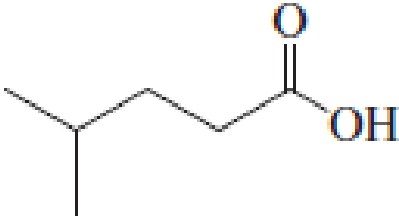
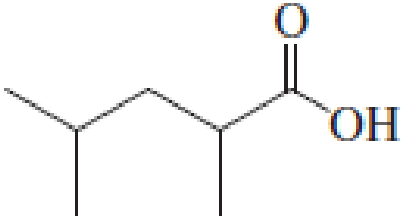
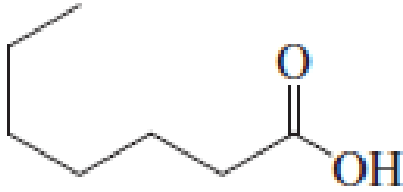

(a)
Interpretation:
IUPAC name for the carboxylic acid has to be given.
Concept Introduction:
For naming a carboxylic acid in IUPAC nomenclature, the suffix “-oic” is added to the parent alkane name.
IUPAC rules for naming a carboxylic acid:
- The longest parent carbon chain is identified that includes the carboxyl group.
- The parent chain name is changed by replacing the suffix “-e” with “-oic acid”.
- Numbering is done in a way that the carboxyl group is designated as number 1. This is not indicated in the part of the name because for aldehyde, the carboxyl carbon is always numbered 1.
- The identity and location of substituents if any has to be determined and this information has to be added in front of the IUPAC name.
- If the carboxyl functional group is attached to a ring of carbon atoms, the ring is named and “-carboxylic acid” is added as suffix.
In a line-angle structural formula the point at which two lines intersect and the end points are carbon atoms.
Answer to Problem 5.16EP
IUPAC name of the given carboxylic acid is 4-methylpentanoic acid.
Explanation of Solution
Given structure of carboxylic acid is,
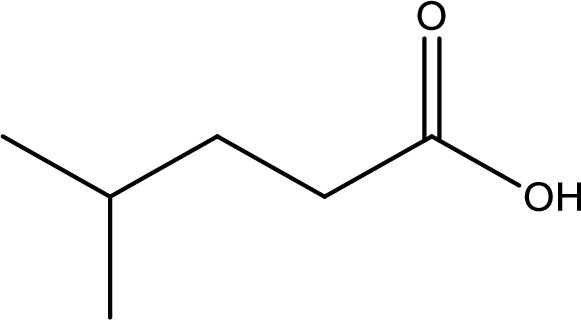
The longest continuous carbon chain has to be found out with the carboxyl group in it. In this it is a five carbon chain. Hence, the parent alkane is pentane. The carboxylic acid is named by replacing the suffix “-e” in the alkane name with “-oic acid”. This gives the name of carboxylic acid as pentanoic acid.
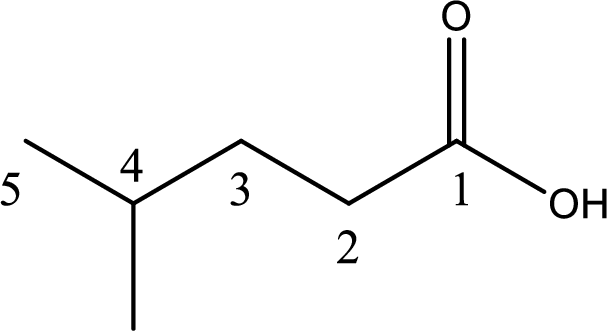
Looking for substituents it is found that there is a methyl group present on fourth carbon atom. Hence, the IUPAC name of the given carboxylic acid is 4-methylpentanoic acid.
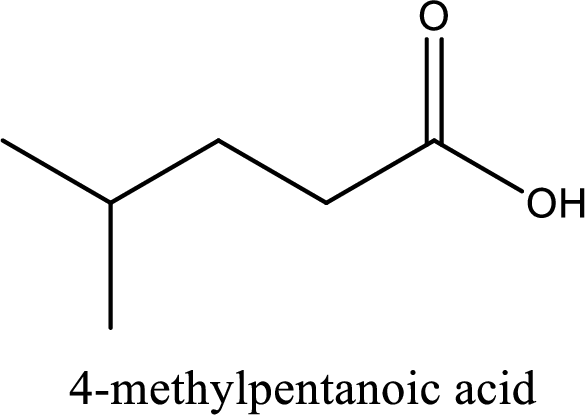
The IUPAC name of the given carboxylic acid is 4-methylpentanoic acid.
IUPAC name of the given carboxylic acid is found out.
(b)
Interpretation:
IUPAC name for the carboxylic acid has to be given.
Concept Introduction:
For naming a carboxylic acid in IUPAC nomenclature, the suffix “-oic” is added to the parent alkane name.
IUPAC rules for naming a carboxylic acid:
- The longest parent carbon chain is identified that includes the carboxyl group.
- The parent chain name is changed by replacing the suffix “-e” with “-oic acid”.
- Numbering is done in a way that the carboxyl group is designated as number 1. This is not indicated in the part of the name because for carboxylic acid, the carboxyl carbon is always numbered 1.
- The identity and location of substituents if any has to be determined and this information has to be added in front of the IUPAC name.
- If the carboxyl functional group is attached to a ring of carbon atoms, the ring is named and “-carboxylic acid” is added as suffix.
In a line-angle structural formula the point at which two lines intersect and the end points are carbon atoms.
Answer to Problem 5.16EP
IUPAC name of the given carboxylic acid is 2,4-dimethylpentanoic acid.
Explanation of Solution
Given structure of carboxylic acid is,
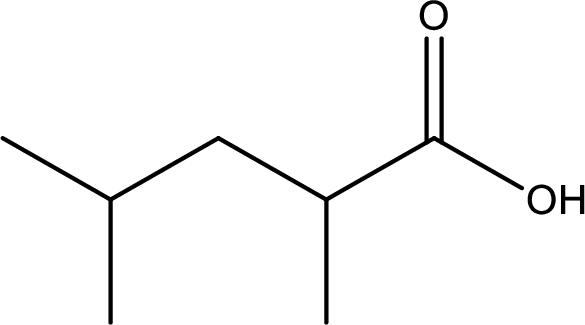
The longest continuous carbon chain has to be found out with the carboxyl group in it. In this it is a five carbon chain. Hence, the parent alkane is pentane. The carboxylic acid is named by replacing the suffix “-e” in the alkane name with “-oic acid”. This gives the name of carboxylic acid as pentanoic acid.
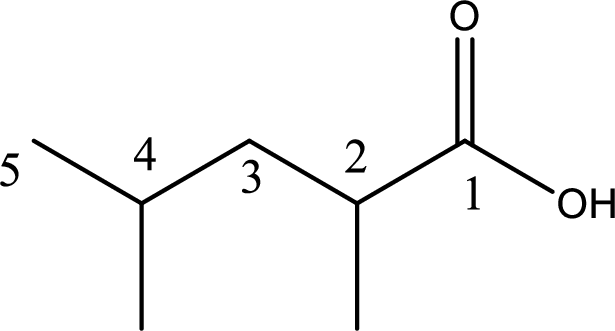
Looking for substituents it is found that there are two methyl groups present, each on second and fourth carbon atom. In the IUPAC name prefix “-di” has to be added before the alkyl name. Hence, the IUPAC name of the given carboxylic acid is 2,4-dimethylpentanoic acid.
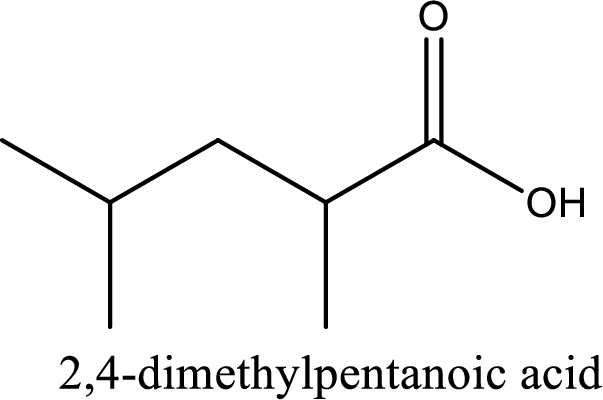
The IUPAC name of the given carboxylic acid is 2,4-dimethylpentanoic acid.
IUPAC name of the given carboxylic acid is found out.
(c)
Interpretation:
IUPAC name for the carboxylic acid has to be given.
Concept Introduction:
For naming a carboxylic acid in IUPAC nomenclature, the suffix “-oic” is added to the parent alkane name.
IUPAC rules for naming a carboxylic acid:
- The longest parent carbon chain is identified that includes the carboxyl group.
- The parent chain name is changed by replacing the suffix “-e” with “-oic acid”.
- Numbering is done in a way that the carboxyl group is designated as number 1. This is not indicated in the part of the name because for aldehyde, the carboxyl carbon is always numbered 1.
- The identity and location of substituents if any has to be determined and this information has to be added in front of the IUPAC name.
- If the carboxyl functional group is attached to a ring of carbon atoms, the ring is named and “-carboxylic acid” is added as suffix.
In a line-angle structural formula the point at which two lines intersect and the end points are carbon atoms.
Answer to Problem 5.16EP
IUPAC name of the given carboxylic acid is heptanoic acid.
Explanation of Solution
Given structure of carboxylic acid is,

The longest continuous carbon chain has to be found out with the carboxyl group in it. In this it is a seven carbon chain. Hence, the parent alkane is heptane. The carboxylic acid is named by replacing the suffix “-e” in the alkane name with “-oic acid”. This gives the name of carboxylic acid as heptanoic acid.
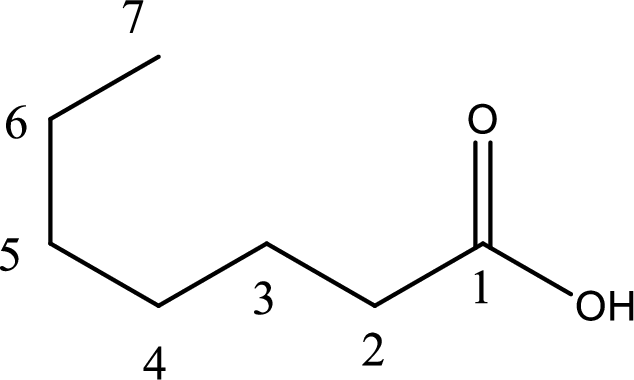
Looking for substituents it is found that there are no substituents present on the carbon chain. Hence, the IUPAC name of the given carboxylic acid is heptanoic acid.
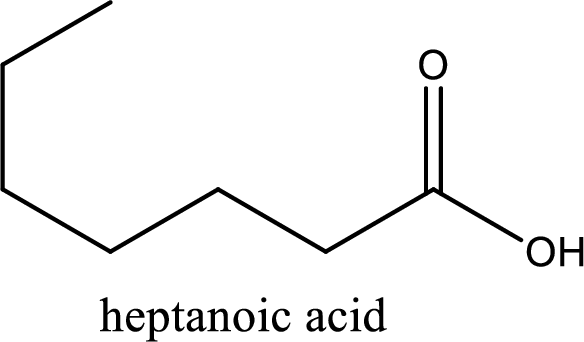
The IUPAC name of the given carboxylic acid is heptanoic acid.
IUPAC name of the given carboxylic acid is found out.
(d)
Interpretation:
IUPAC name for the carboxylic acid has to be given.
Concept Introduction:
For naming a carboxylic acid in IUPAC nomenclature, the suffix “-oic” is added to the parent alkane name.
IUPAC rules for naming a carboxylic acid:
- The longest parent carbon chain is identified that includes the carboxyl group.
- The parent chain name is changed by replacing the suffix “-e” with “-oic acid”.
- Numbering is done in a way that the carboxyl group is designated as number 1. This is not indicated in the part of the name because for aldehyde, the carboxyl carbon is always numbered 1.
- The identity and location of substituents if any has to be determined and this information has to be added in front of the IUPAC name.
- If the carboxyl functional group is attached to a ring of carbon atoms, the ring is named and “-carboxylic acid” is added as suffix.
In a line-angle structural formula the point at which two lines intersect and the end points are carbon atoms.
Answer to Problem 5.16EP
IUPAC name of the given carboxylic acid is 3,5-dimethylheptanoic acid.
Explanation of Solution
Given structure of carboxylic acid is,

The longest continuous carbon chain has to be found out with the carboxyl group in it. In this it is a seven carbon chain. Hence, the parent alkane is heptane. The carboxylic acid is named by replacing the suffix “-e” in the alkane name with “-oic acid”. This gives the name of carboxylic acid as heptanoic acid.

Looking for substituents it is found that there are two methyl groups present as substituents, each on third carbon atom and fifth carbon atom. Hence, the IUPAC name of the given carboxylic acid is 3,5-dimethylheptanoic acid.
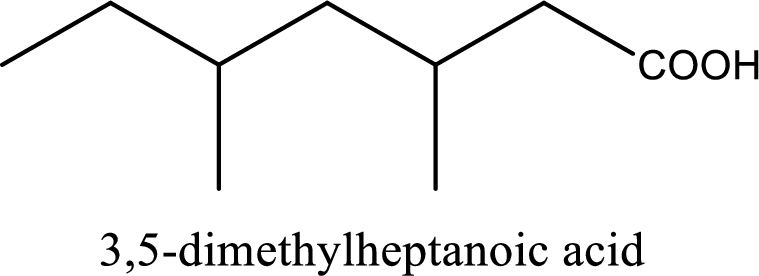
The IUPAC name of the given carboxylic acid is 3,5-dimethylheptanoic acid.
IUPAC name of the given carboxylic acid is found out.
Want to see more full solutions like this?
Chapter 5 Solutions
EBK ORGANIC AND BIOLOGICAL CHEMISTRY
- 03 Question (1 point) For the reaction below, draw both of the major organic products. Be sure to consider stereochemistry. > 1. CH₂CH₂MgBr 2. H₂O 3rd attempt Draw all four bonds at chiral centers. Draw all stereoisomers formed. Draw the structures here. e 130 AN H See Periodic Table See Hint P C Brarrow_forwardYou may wish to address the following issues in your response if they are pertinent to the reaction(s) you propose to employ:1) Chemoselectivity (why this functional group and not another?) 2) Regioselectivity (why here and not there?) 3) Stereoselectivity (why this stereoisomer?) 4) Changes in oxidation state. Please make it in detail and draw it out too in what step what happens. Thank you for helping me!arrow_forward1) Chemoselectivity (why this functional group and not another?) 2) Regioselectivity (why here and not there?) 3) Stereoselectivity (why this stereoisomer?) 4) Changes in oxidation state. Everything in detail and draw out and write it.arrow_forward
- Calculating the pH at equivalence of a titration 3/5 Izabella A chemist titrates 120.0 mL of a 0.7191M dimethylamine ((CH3)2NH) solution with 0.5501 M HBr solution at 25 °C. Calculate the pH at equivalence. The pk of dimethylamine is 3.27. Round your answer to 2 decimal places. Note for advanced students: you may assume the total volume of the solution equals the initial volume plus the volume of HBr solution added. pH = ☐ ✓ 18 Ar Boarrow_forwardAlcohols can be synthesized using an acid-catalyzed hydration of an alkene. An alkene is combined with aqueous acid (e.. sulfuric acid in water). The reaction mechanism typically involves a carbocation intermediate. > 3rd attempt 3343 10 8 Draw arrows to show the reaction between the alkene and hydronium ion. that 2nd attempt Feedback 1st attempt تعمال Ju See Periodic Table See Hint F D Ju See Periodic Table See Hintarrow_forwardDraw the simplified curved arrow mechanism for the reaction of acetone and CHgLi to give the major product. 4th attempt Π Draw the simplified curved arrow mechanism T 3rd attempt Feedback Ju See Periodic Table See Hint H -H H -I H F See Periodic Table See Hintarrow_forward
- Select the correct reagent to accomplish the first step of this reaction. Then draw a mechanism on the Grignard reagent using curved arrow notation to show how it is converted to the final product. 4th attempt Part 1 (0.5 point) Select the correct reagent to accomplish the first step of this reaction. Choose one: OA Mg in ethanol (EtOH) OB. 2 Li in THF O C. Li in THF D. Mg in THF O E Mg in H2O Part 2 (0.5 point) Br Part 1 Bri Mg CH B CH, 1 Draw intermediate here, but no arrows. © TE See Periodic Table See Hint See Hint ין Harrow_forwardSelect the product for the following reaction. HO HO PCC OH ○ OH O HO ○ HO HO HOarrow_forward5:45 Х Select the final product for the following reaction sequence. O O 1. Mg. ether 2.D.Oarrow_forward
- Based on the chart Two similarities between the molecule with alpha glycosidic linkages. Two similarities between the molecules with beta glycosidtic linkages. Two differences between the alpha and beta glycosidic linkages.arrow_forwardplease help fill in the tablearrow_forwardAnswer F pleasearrow_forward
 Organic And Biological ChemistryChemistryISBN:9781305081079Author:STOKER, H. Stephen (howard Stephen)Publisher:Cengage Learning,
Organic And Biological ChemistryChemistryISBN:9781305081079Author:STOKER, H. Stephen (howard Stephen)Publisher:Cengage Learning, General, Organic, and Biological ChemistryChemistryISBN:9781285853918Author:H. Stephen StokerPublisher:Cengage Learning
General, Organic, and Biological ChemistryChemistryISBN:9781285853918Author:H. Stephen StokerPublisher:Cengage Learning

